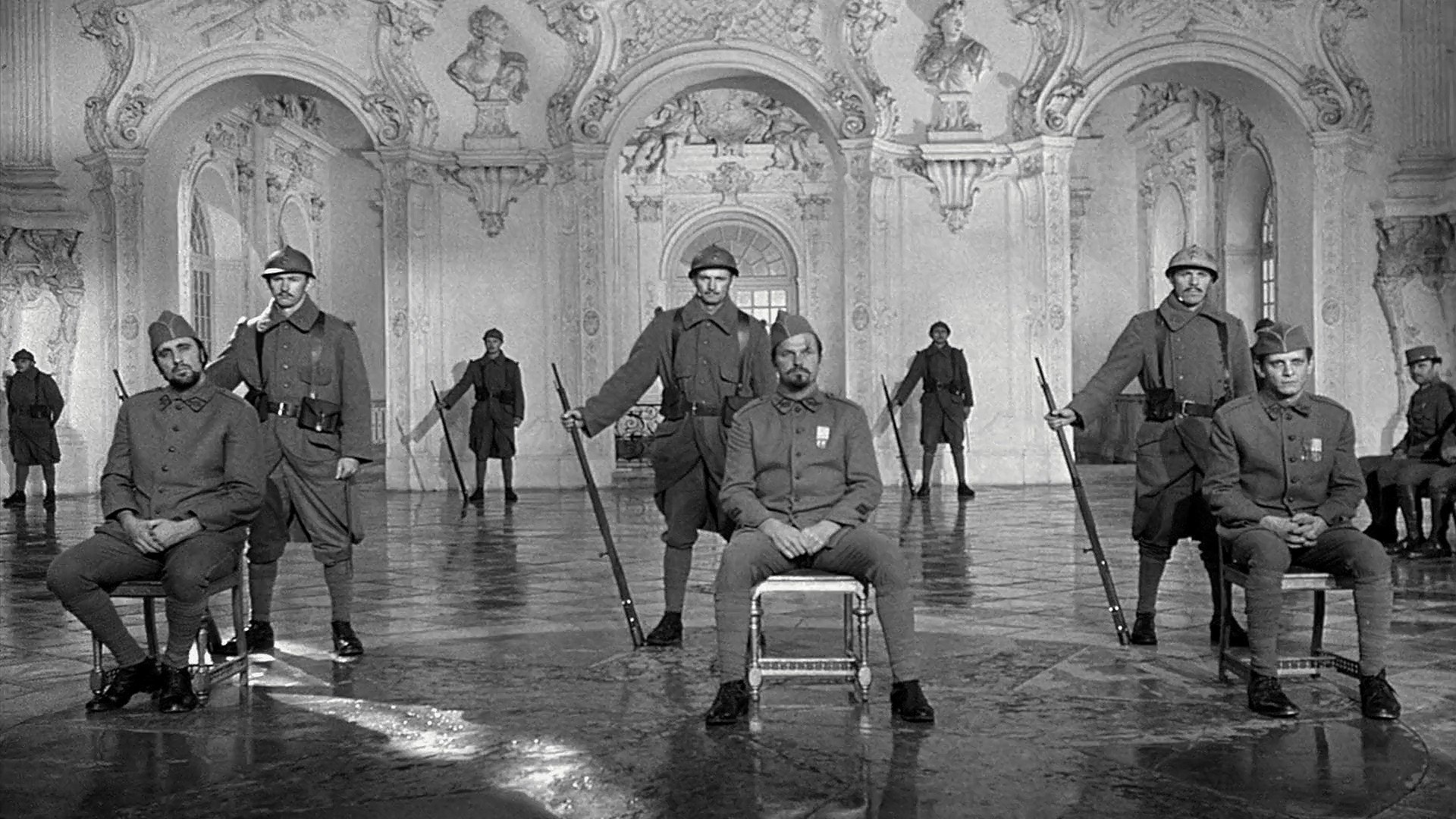With mocking outrage at all vainglorious military hierarchies, Stanley Kubrick’s Paths of Glory continues to exude its power to the present day.
The Production: 5/5
One of the greatest antiwar films that’s not actually about war itself but about the disparate personalities of war’s participants, Stanley Kubrick’s Paths of Glory is a movie whose power and resonance has only grown in the decades since its initial, unprofitable release. Concerned mostly with an examination into the inflated egos and prideful personalities that are at the core of the decision-making during war strategizing, Paths of Glory paints a very ugly picture of the military’s ego-inflated hierarchal structure. Though focusing specifically on an incident in the French army during World War I (which so enraged the powers that be that the movie was banned in France for decades), it’s really not a condemnation of French politics but really a finger-wagging protestation of all politics in which leaders make cavalier decisions about human beings without the best interests of the people under their command as part of their deliberations.
In France in 1916, General Paul Mireau (George Macready) is coerced into sending his regiment on a certain suicide mission to claim the impregnable “Anthill” position against the Germans by clever General George Broulard (Adolphe Menjou)’s promises of eternal glory and another star on his uniform. Though he knows his already depleted regiment will lose more than half of its men on such a foolhardy mission, Mireau directs Colonel Dax (Kirk Douglas) to carry out his orders. During the attack, portions of the regiment are under such heavy fire that they can’t even leave their foxholes, a situation which so embarrasses Mireau that when the mission fails, he ragingly orders that three scapegoats be found to face military court martial for cowardice. Colonel Dax, astounded that men would be put on trial for such a wrongheaded decision from the top and on charges that are patently false, elects to defend the men during their court martial.
The script by Stanley Kubrick, Calder Willingham, and Jim Thompson (though several sources claim that Willingham did most of the writing) is based on the antiwar novel by Humphrey Cobb. Kubrick went on in future films to show the outrageous egotistical idiocy of military powerbrokers, but Paths of Glory did it first and perhaps best with less obvious satire than Dr. Strangelove, of course, and more matter-of-factly than in Full Metal Jacket. The nonchalant air in which these generals talk about lives as if they were tissues easily used and just as easily discarded is appalling, a theme that would fuel many antiwar films after this one in the 1960s once Vietnam became the subject of so much nationwide contention. Kubrick’s camera puts us right into the trenches (stupendous tracking shots without the use of Steadicam follow the general and later the colonel weaving intricately through the structures) and into and across No Man’s Land with shells exploding all around us and the grit and grime of war palpable in every frame (in one incredible moment an overhead flair shows us a battlefield that we thought empty is actually strewn with bodies). And then later, when we’re at the military tribunal held in an ironic palatial ballroom, the contrast couldn’t be more stunning, emphasized by Kubrick who films it with such fantastic flexibility and variety: close-ups and long shots, from above and below speakers who sometimes occupy center frame and at other times are found at the extreme edges using his film canvas with such startling inventiveness.
Kirk Douglas plays the outraged and frustrated Colonel Dax with (unusual for him) restrained but undeniable fire, and it’s one of his most controlled and effective performances. George Macready as the supercilious General Mireau is loathsome in his injured vanity and pompous humility, probably his greatest-ever performance. Adolphe Menjou doesn’t press too hard with his superiority amid the peacocks who surround him making his General Broulard’s cageyness and guile all the slimier. As the three condemned men, Ralph Meeker, Joseph Turkel, and Timothy Carey all etch memorable portraits of soldiers as victims of the corrupt system. Wayne Morris as the cowardly Lieutenant Roget who sends the man who knows his guilty secret to his death and Richard Anderson as the fawning flunky to General Mireau are also unforgettable.
Video: 4.5/5
3D Rating: NA
The film has been framed at 1.66:1 and is presented in 2160p using the HEVC codec. Sharpness is all one could wish for as details etched on faces couldn’t be any more exact. The HDR/Dolby Vision application brings out specular highlights brilliantly in the stark black and white photography including facial highlights (an unforgettable moment with the general and the colonel in his quarters with a glaring overhead light bulb illuminating crevices and folds in their faces) and later really emphasizing streaming sunlight through windows and doors along with the bombs and flares during battle giving the images an almost constant three-dimensional quality. Black levels are also wonderfully deep. At the twenty-five-minute mark, there appears to be some spotting along the right side of the frame that has been somewhat unsuccessfully dealt with, but that is the only blemish in an otherwise beautiful transfer.
Audio: 5/5
The DTS-HD Master Audio 2.0 mono sound mix is most effective. The audio track blends the dialogue, the explosive battle sound effects, and music into an engaging and masterful whole. The occasional slight hiss present on the Criterion Blu-ray is not present here, nor are there any other age-related artifacts such as pops, crackle, hum, or flutter.
Special Features: 2/5
Audio Commentary: novelist and critic Tim Lucas contributes an expert commentary track offering film analysis, background on all the principal participants before and behind the camera, comparisons to the original novel and the screenplay, and even pointing out a couple of gaffes that the film’s low budget wouldn’t allow to be corrected. Fans of the movie will find it illuminating.
Theatrical Trailer (3:00, HD)
Kino/Kubrick Trailers: Killer’s Kiss, The Killing
Reversible Cover Art
Overall: 4.5/5
With mocking outrage at all vainglorious military hierarchies, Stanley Kubrick’s Paths of Glory continues to exude its power to the present day, and in an era where military decisions around the world still confound and appall us on a regular basis, its message has perhaps never been more pertinent. The Kino UHD release, taken from a brand new 4K scan of the original camera negative, offers this first Kubrick masterpiece in a condition it fully deserves. Highly recommended!
Matt has been reviewing films and television professionally since 1974 and has been a member of Home Theater Forum’s reviewing staff since 2007, his reviews now numbering close to three thousand. During those years, he has also been a junior and senior high school English teacher earning numerous entries into Who’s Who Among America’s Educators and spent many years treading the community theater boards as an actor in everything from Agatha Christie mysteries to Stephen Sondheim musicals.
Post Disclaimer
Some of our content may contain marketing links, which means we will receive a commission for purchases made via those links. In our editorial content, these affiliate links appear automatically, and our editorial teams are not influenced by our affiliate partnerships. We work with several providers (currently Skimlinks and Amazon) to manage our affiliate relationships. You can find out more about their services by visiting their sites.








Similar threads